The lessons are:
1. Don’t rob banks. In fact, “Don’t rob” covers it.
2. Don’t initiate your explosive device while stood next to it.
3. Don’t run away leaving money lying around.
4. Don’t wear flip flops while robbing banks.
(seriously, flip flops?)
The lessons are:
1. Don’t rob banks. In fact, “Don’t rob” covers it.
2. Don’t initiate your explosive device while stood next to it.
3. Don’t run away leaving money lying around.
4. Don’t wear flip flops while robbing banks.
(seriously, flip flops?)
I’ve been doing more research on the IEDs used by the Irish “volunteers” between 1919 and 1922 and found some interesting aspects. One should remember the time-line of Irish Republicanism that these events of 1919-1922 sit on – Irish revolutionaries were using explosive devices much earlier, certainly as early as 1803, IEDs were used extensively by the Fenians in the latter half of the 19th century, again in 1939 and of course from 1970 onwards. The window of 1919-122 is just one point on the time line, but is worthy of study for all that.
Firstly, explosives, and I apologise for being somewhat circumspect in the detail here – no need to give modern day revolutionaries with other causes the full recipes. EOD folk can approach me directly of course and I’ll point you in the right direction if I know you. At the beginning of the campaign the explosives used was gelignite stolen from quarries, along with “No 6” detonators. This supply began to become more difficult to obtain and so the Irish volunteers identified chemists and pharmacists and those with military experience from WW1 to develop home made explosives (HME). There were three types, each given a nickname. I won’t describe their manufacturing process:
“Warflour”: Warflour was a nitrated resin, using the ingredients of resin, flour, acid and potassium chlorate.
“Irish Cheddar”: This was the nickname for a form of cheddite, an explosive used quite extensively in the early 20th century, its ingredients being potassium chlorate, nitrobenzene and castor oil. Some sources suggest that “Cheddar” included home made DNT. As an aside, this HME was used extensively by the Polish underground in WW2 in their IEDs, which I’ll write about in a future blog post.
“Paxo”. This was a mix of potassium chlorate and paraffin wax. It was the favoured HME in the 1939 campaign but was developed during this period.
The IRA also developed its own detonators at the time, and I won’t describe them here other than to say that interestingly they were non-metallic and quite an effective design.
In terms of IEDs, and further to my earlier post, the IRA of the time made several thousand grenades, mostly under the Dublin Bicycle shop at 198 Parnell St and latterly at other facilities. It appears that the design of these were copied from the German “Egg” grenade of WW1. These were essentially quite a simple design,small and preferred because they were easier to conceal than a larger grenade. They used the standard sort of fuze with a spring-loaded fly-off lever. Occasionally larger improvised grenades were used – this is a diagram of one of them, made by an IRA engineer involved in their manufacture.
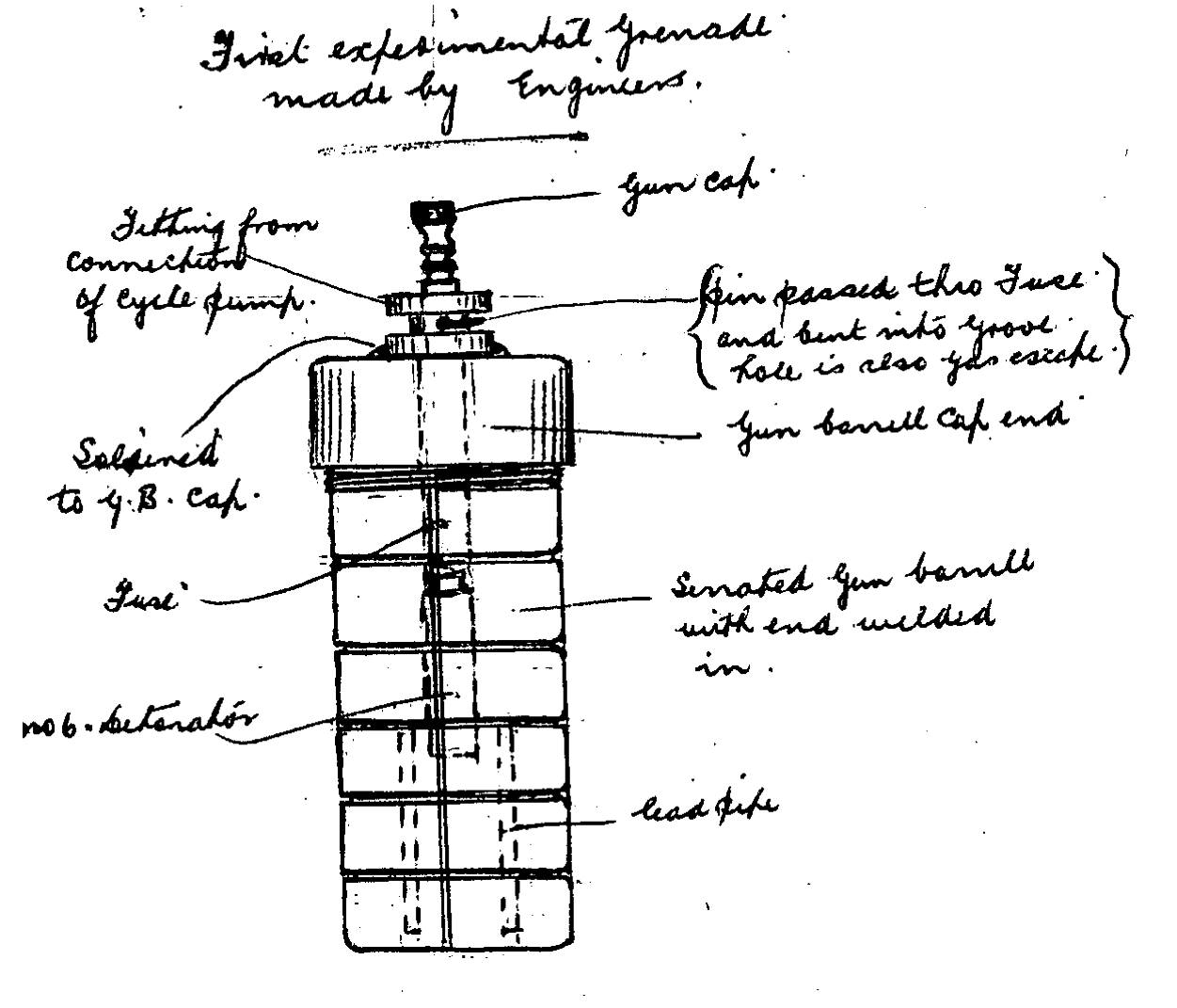
IEDs used for roadside ambushes were usually cylindrical pipes, either drain pipes or preferably the cylinders from a cart axle, filled with gelignite or HME and electrically initiated. The IRA of the time were ambushing British troops on the roads and certainly learned the trick of laying multiple roadside IEDs at the same spacing as convoy vehicles. I can find little record of timed IEDs of the time, but the later 1939 “S-Plan” campaign in Great Britain concentrated on the use of timed IEDs. The cylinders were closed by two end plates – initially with a bolt running down the central axis, and later by a bolt that fitted to the outside of the cylinder. Command wire initiated devices of this type were occasionally adapted to be come booby traps by the use of a grenade striker system. The diagram below, drawn by an IRA man shows one such IED.
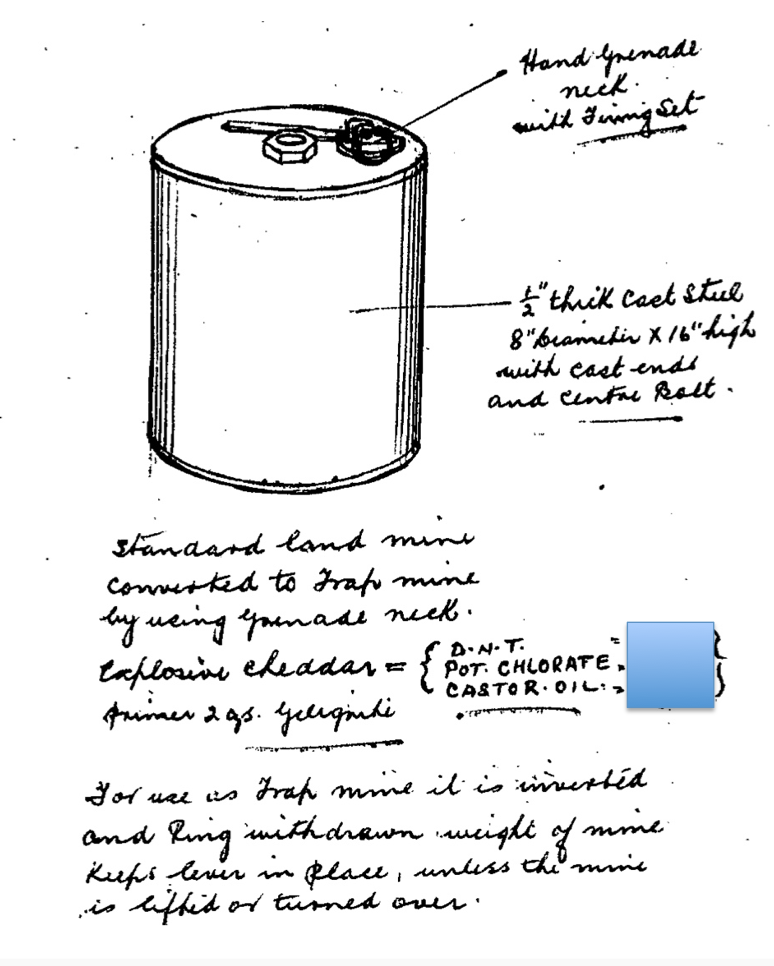
Further research into the improvised IRA mortar described in my earlier post has thrown up more interesting facts. The background to the IRA requirement was that their roadside campaign was increasingly forcing the police and military to confine themselves to barracks (today we might call them “FOBs”), and the IRA leadership felt they needed a means to attack these barracks directly. A number of IRA members had fought in the British Army in WW1 and had experienced trench mortars, either as a user or recipient. The IRA funded a secret delegation to visit Germany and buy arms on the black market , including a German trench mortar but this mission was unsuccessful. As a fall-back they asked their engineers to develop a home made mortar based on the British “Stokes” trench mortar. I’m not sure how closely they followed the design, but the IRA version appears to have been of same calibre as the Mk 1 Stokes mortar (3 inch) and projected an 11lb mortar bomb, again the same as a Mk 1 Stokes mortar. It appears that the IRA was able to obtain British Army manual for the Stokes mortar. the tube was made by Matt Furlong’s brother, Joe, at a railway workshop, and Matt (who later died testing a version of the mortar) made the bombs for it at 198 Parnell St.
Additional research leads me to believe that the additional safety feature in the mortar fuze that Matt Furlong removed before his accident was remarkably similar to a fuze safety feature I saw in 1990 or 1991 – on another IRA mortar. That’s seventy years apart, and essentially the same safety feature being used on an improvised mortar.
Earlier bogs have reported the use of Irish revolutionary improvised munitions as far back as 1803. Use of IRA improvised weapons has been a theme for hundreds of years. I have found a long and detailed statement by an IRA weapons engineer called Patrick McHugh, given in 1952 which sheds some remarkable insight into IRA improvised weapon production between 1919 and 1922. It is generally thought that IRA imporvised mortar development started in 1970, but this shows that that date is out by about 50 years.
In 1919 the Irish volunteers established an “underground” muntions factory at 198 Parnell St in Dublin, under Michael Lynch, disguised in the cellar of a cycle business called “Heron and Lawless”. The facility was equipped with a furnace and a mould trough for casting grenade casings, a forge and a lathe. An electric light was controlled by a switch to the shop above and used to warn of danger. In such an emergency grenade casing and parts could be hidden in the forge bellows.
All moulding and casting of grenades and “shells” was done in small moulding boxes, each box containing eight shells. Both brass and iron were cast – brass for the fuze fittings. Then subsequent machining of the cast components was also undertaken at the premises. The output was about 100 improvised grenades a week, and the cost was established as 9 shillings per grenade.
The grenades , empty, were taken to a room in a house in Dominick St were they were filled with gelignite explosive and fuzed. The grenade was small and described as the size of a duck egg. This is a description of the fuze mechanism, verbatim from McHugh:
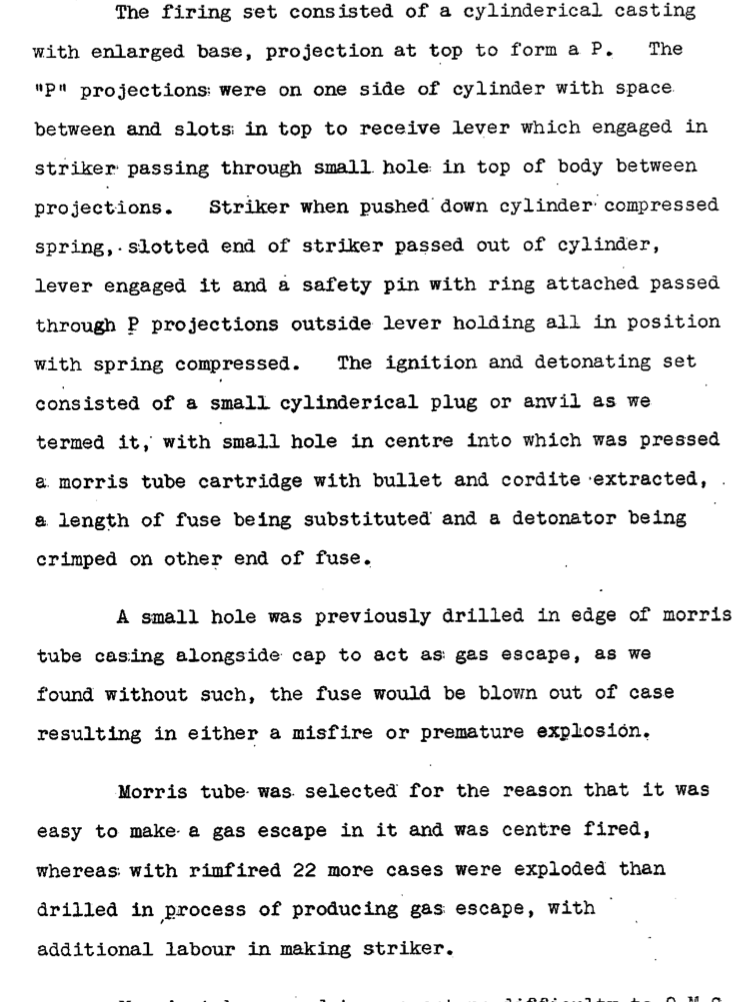
It is a little difficult to interpret without a diagram. My assessment is that a safety pin held a spring striker. The striker struck a centre fired bullet case, with bullet and propellant removed and a short length of delay fuse inserted, and the other end having a detonator crimped on.
The detonators were commercial and obtained from quarries. The time delay was nominally set for 4 seconds. Amusingly the lathe used had originally belonged to a jewellers, “Ganter’s”. When WW1 started the lathe was requisitioned by the British government and used in manufacturing shells for the British war effort. Mr Ganter than made a a formal application for it to be returned. When he got it back he sold it to the IRA for the same purpose. Other tools were obtained from the Broadstone works of the Midland railway. The springs for the grenade fuzes were obtained by a front business importing long springs from overseas and cutting them down to size. Strikers were iron rivets with the head turned down in a lathe to a sharp point. As an aside I have on my desk in front of me another IRA striker from a fuze mechanism and it’s a much cruder design from 1991. The facility was raided twice by the British but on both occasions they found nothing.
Michael Lynch then designed an improvised mortar in 1920. The propellant charge was a 12 bore shotgun cartridge with shot removed and more propellant (black powder) added. The impact fuze was adapted from the grenade fuze, but without the delay. The mortar bomb weighed 11lbs.
The IRA under Matt Furlong conducted some extensive trials of this improvised mortar system in October 1920 in County Meath. First a number of dummy mortar bombs with propellant only were fired, to establish ranges and calculate the propellant charge needed for a range of 100 yards. Then three bombs were fired without a main charge but with an impact fuze fitted to test initiation. The trials established that the bomb tumbled through the air, but despite that, the fuze appeared to work however it struck the ground. One of the engineers believed that the impact fuze was being initiated on “set back” within the mortar tube and not on impact at the target. Attempts to fire a live mortar failed as the bomb got stuck in the tube. Probably fortunately.
The engineers involved were concerned about the impact fuze functioning on “set back” within the mortar tube, so they added an additional safety mechanism (which I won’t describe here) and this was was built in to the fuze for subsequent trials. The second set of trials took place near Kells in County Meath. After firing a live shell with the new safety feature which then failed to function on impact, an argument ensued between Furlong and McHugh. Matt Furlong insisted on removing the additional safety feature and firing the mortar as originally designed. McHugh, nervous, stepped a few yards away. The others retreated. As the mortar bomb was launched it did indeed explode in the tube, severely injuring Matt Furlong, who later died in hospital.
The loss of the mortar was seen as a significant blow to the IRA in Dublin who had expected to be able to mortar British positions and barracks with impunity mounting the mortar on the back of a vehicle, a tactic that they applied successfully 60 years later in the North.
198 Parnell St in Dublin then upped its production of grenades and became a significant munitions store – because it was no longer possible to conceal the product, a steel plate was fitted behind the shop counter and a pistol and grenades kept at the counter itself. In the end the British came across the munition factory and store by accident when no-one was there.
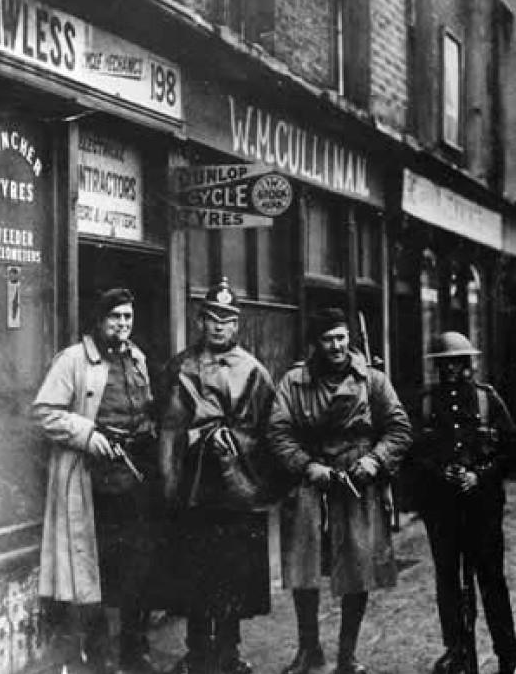
British Forces outside the bicycle shop after the raid.
Other grenade production facilities were established in 1921, with a production capacity of 1000 per week. Later production facilities became even more industrial with revised casting technology improving manufacture. Security too, improved. Every production facility was emptied as work finished so any raids would be inconclusive. Finished munitions were kept in hides, and there was a full time organisation to move them around the city. Faked books to disguise legitimate production runs of legal products were generated, and secret dumps of reserve material were established. McHugh claimed to have personal knowledge of still extant dumps from that time even in 1952 “just in case”.
In 1922 work began on a new IRA mortar, this time based on an oxygen gas cylinder (I kid you not!). The cylinder was used for a barrel, and the mortar bombs were cast iron, pear shaped with 4 fins. The launch tripod was fitted with a quadrant and pendulum to set the angle. The propellant was a shotgun cartridge, again with an augmenting charge of blackpowder. (In 1997 I was still encountering improvised mortars using a blackpowder charge). Trials were undertaken in late 1922 outside Buttevant Barracks. The mortar bombs launched, tumbling as they reached full height then fell nose first. The mortar was used by the IRA in an action against Free State forces in Kilmallock and again at Macroom.
Recently I had a dialogue with some colleagues as I researched modern versions of this very early piece of EOD equipment from 1573.
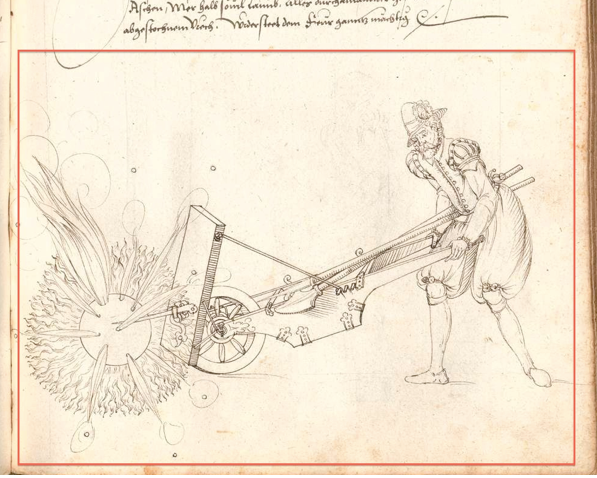
A remarkably similar piece of equipment was in operational use only 45 years ago and I was seeking a photo of the equipment in use in the 1960’s/1970s. I’m still digging on that.
Anyway the dialogue with a few modest practitioners of the art of EOD in the 1970s took me in an interesting direction, and I’ve turned up some interesting stuff from much earlier on the subject of ROVs. The general perception of the world we live in is that the tracked ROV as used in EOD is a very modern invention. Manufacturers produce glitzy videos showing these twin-tracked vehicles performing tricks as the operator remains a safe distance behind, secure from the hazards that their robotic buddy faces. All very High-Tech. I used to work for one such manufacturer, and we have all seen the videos showing the technological prowess of a wide range of differing modern ROVs. Like many, I assumed that the tracked ROV was essentially invented for the purpose of EOD in the dark days of the early 1970s. But it appears that ROVs were around for a considerable time before the 1970s. This does not to lessen in any way the significant innovative effort that went into the development of the “wheelbarrow” series of ROVs and all subsequent EOD “robotics”, but there are some fascinating precedents.
I began by searching for images of the first ROVs in Northern Ireland in about 1972, in the hope that they might also show images of the protective screen I was looking for so I could do a visual comparison. Suddenly I came across a picture in some archives that made me sit up. You should understand that my operational experience was largely in the 1990s so I’m most familiar with Mk8 “wheelbarrow” ROV. But I came across the image which at first glance appeared to show a number of Mk 8 Chassis…. but from WW2… How could that be?
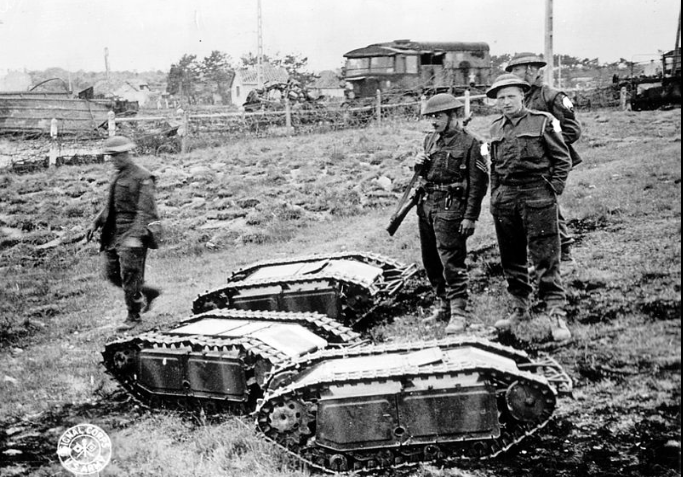
British soldiers with captured Goliaths
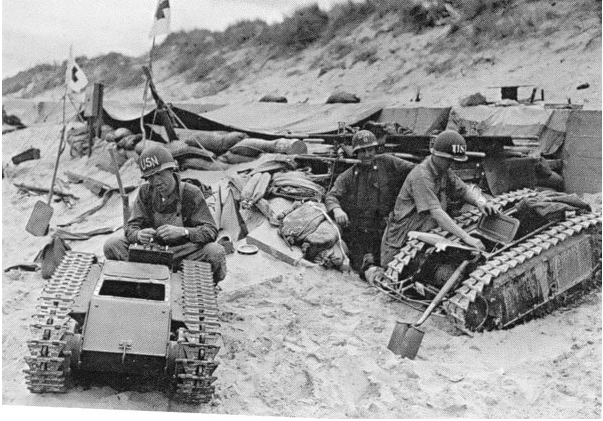
US Navy examine captured Goliaths on Utah Beach 11 June 1944
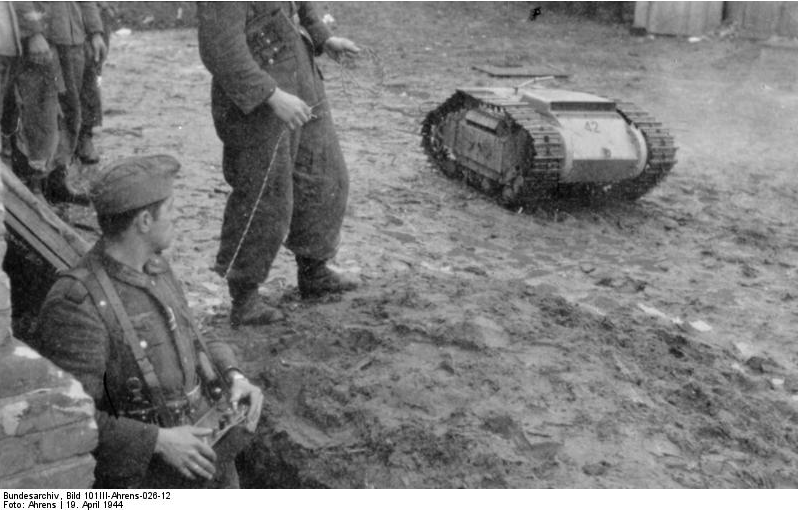
For comparison here’s a picture of a Mk 8 wheelbarrow – note that the main body of the Mk 8 is remarkably similar to the images above in terms of shape and scale.
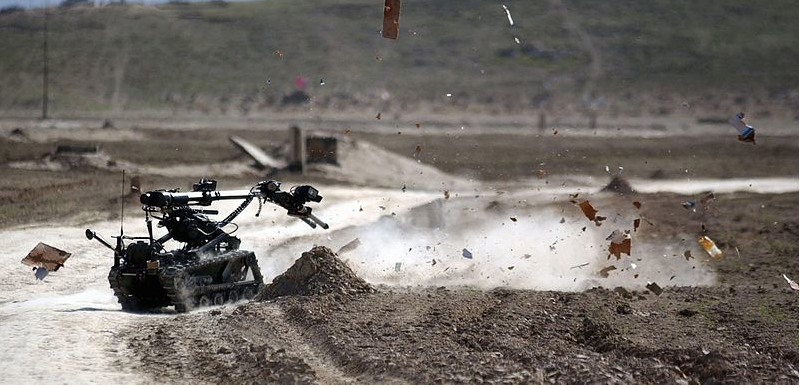
The WW2 item turns out to be of a system called Goliath. It’s not an EOD ROV, but rather its a remotely controlled demolition vehicle.
When you think that probably there were only a couple of hundred Mk 8 wheelbarrows produced in the 1980s and 1990s, but there were many thousand “Goliath” ROVs produced. The Goliath ROVs were initially electrically powered but later used a small two cylinder engine. Here’s a great shot from the top, showing the engine and the wire spooling from the rear.
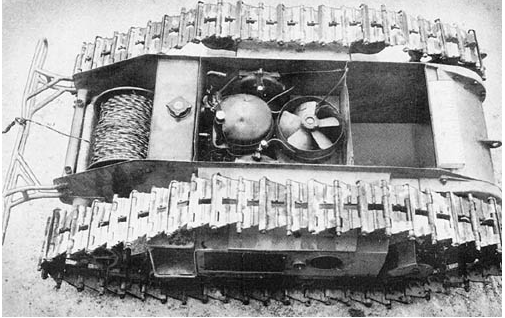
I also found reference to a Japanese tracked ROV, also used a a remote demolition tool – called the “I-GO” developed in 1937. How strange that the nomenclature predates the “I-Robot”
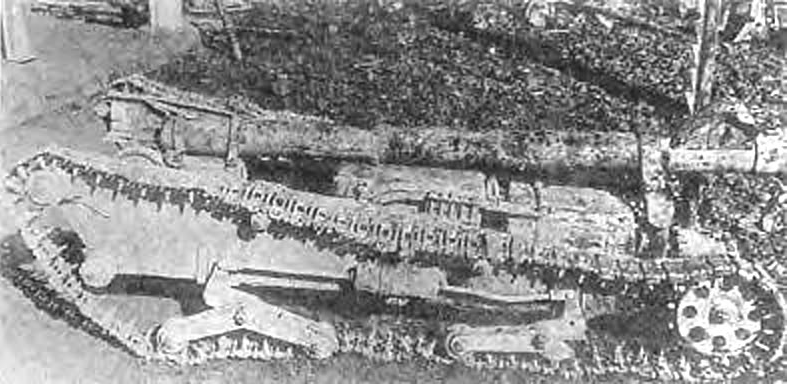
Japanese I-GO ROV from 1937
Now in the early 1990s some of the Northern Ireland EOD units developed a deployment technique called the “Rapid Deployment Trolley”. This was a cobbled together wheeled trolley on which we placed the Mk 8 wheelbarrow ROV to transport it rapidly to and from a small helicopter in emergency situations where a full deployment requiring a large helicopter wasn’t possible. So it was with delight I saw that Germans in WW2 also had such a “trolley” for the Goliath – and actually theirs looked much better engineered!. Vorsprung Durch Technic.
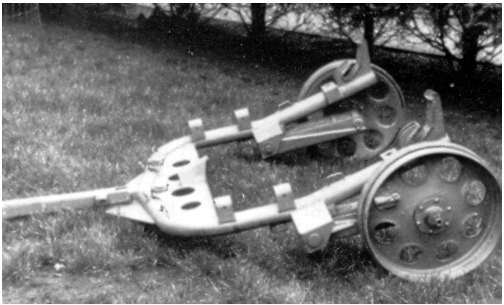
Wheeled Trolley for moving Goliath ROVs
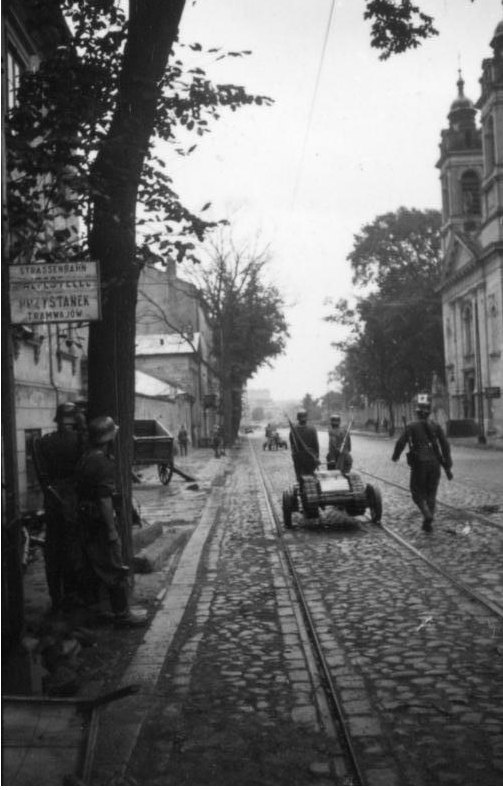
A Goliath being moved on its wheeled Trolley, Warsaw
Then as I was researching the provenance of the German Goliath I came across reference to the genesis of this equipment… It turns out that the German Goliath was based on an ROV developed by the French in the years running up to WW2…. Supposedly, as the Germans advanced on Paris the inventor, Adolphe Kegresse threw the prototype into the Seine, but somehow the Nazis got wind of this, reverse-engineered it, and ended up building the Goliath. I have also found reference to the Germans recovering , later, Kegresse’s blueprints for the ROV and reverse engineering their ROV from that.
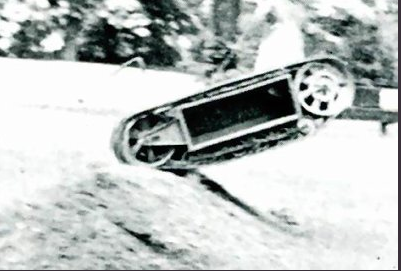
The French Kegresse ROV, 1940
I then found details of British tracked ROV, developed in 1940 by Metropolitan Vickers, again as a remote demolition tool. Here’s an image – note the interesting inwardly facing track extensions.
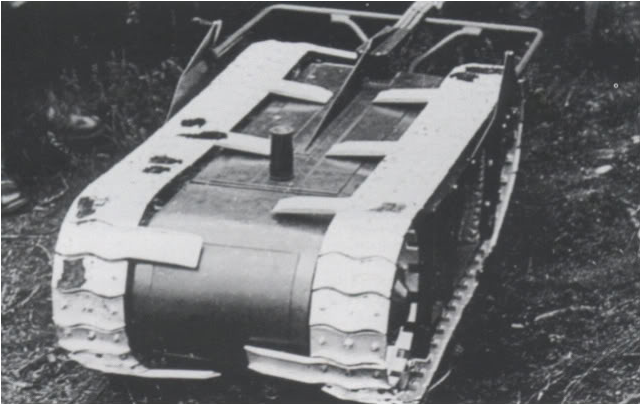
Vickers MLM ROV, 1940
50 of these Vickers MLMs were built before the project was suspended in 1944. I have a copy of a Canadian officer’s trial report if anyone is interested. The ROV had a range of 1100 yards and could carry 120lbs of Ammonal. Initiation was either by a command signal or a contact switch (which had a command safety override).
I then found a reference to an American ROV from WW1. This is the Wickersham Land Torpedo, built in 1918, possibly 1917 but patented in 1922. Here’s the link to the patent. They were manufactured by the Caterpillar company, I think.
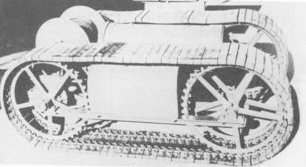
Wickerhsam Land Torpedo
This ROV looks similar in size shape and design to a modern day Talon EOD ROV, or a Dragon Runner. The Wickersham and the Kegresse ROVs look pretty similar.
I kept digging and encountered 2 more tracked ROvs that predates the American one – both French.
The first of these was the “torpille terrestre electrique” (electrical land torpedo), developed by M. Gabet and M. Aubriot in 1915. It could carry 200kgs of explosive and was wire guided of course. I’m intrigued that the single lever track at the rear looks a little like the lever track on some modern robots.
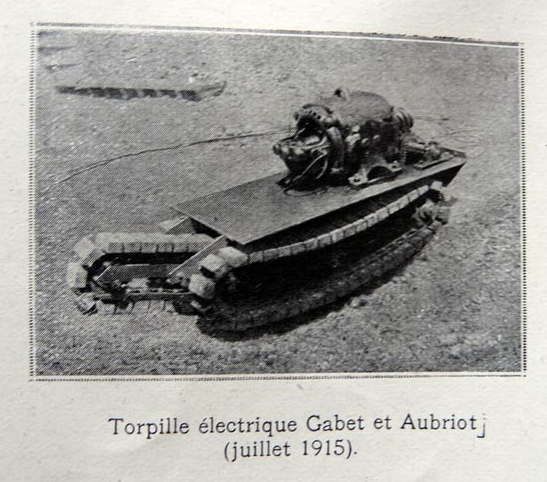
The second of these was the “Schnieder Crocodile” also developed in 1915 and trialled by many Allied nations, including the British, Belgian, Italian and Russians.
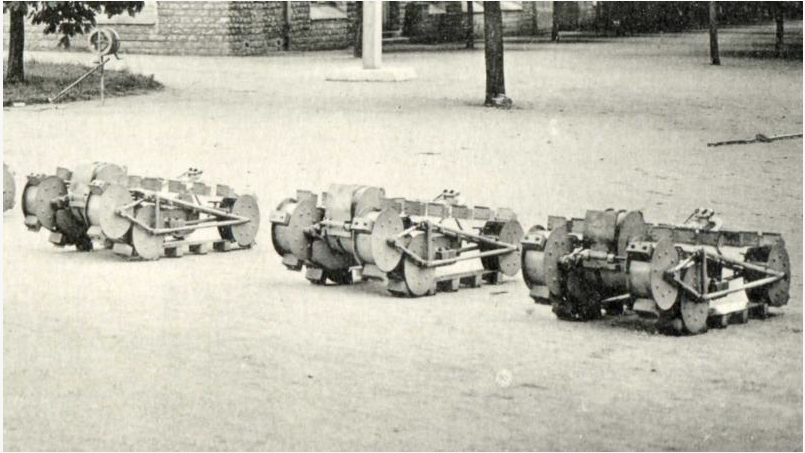
“Crocodiles” Schneider type B.
It could carry 40kg of explosives and looks similar in size, shape and scale to the Allen-Vanguard ROV
So it seems that next year will be the centenary of the tracked ROV…
 Roger Davies
Roger DaviesHere’s a video showing that the Gemeran Goliath ROV was also radio controlled, and not just command wire steered.
There are numerous illicit markets on the dark web, one of which is “Evolution”. Here’s an interesting item for sale there:
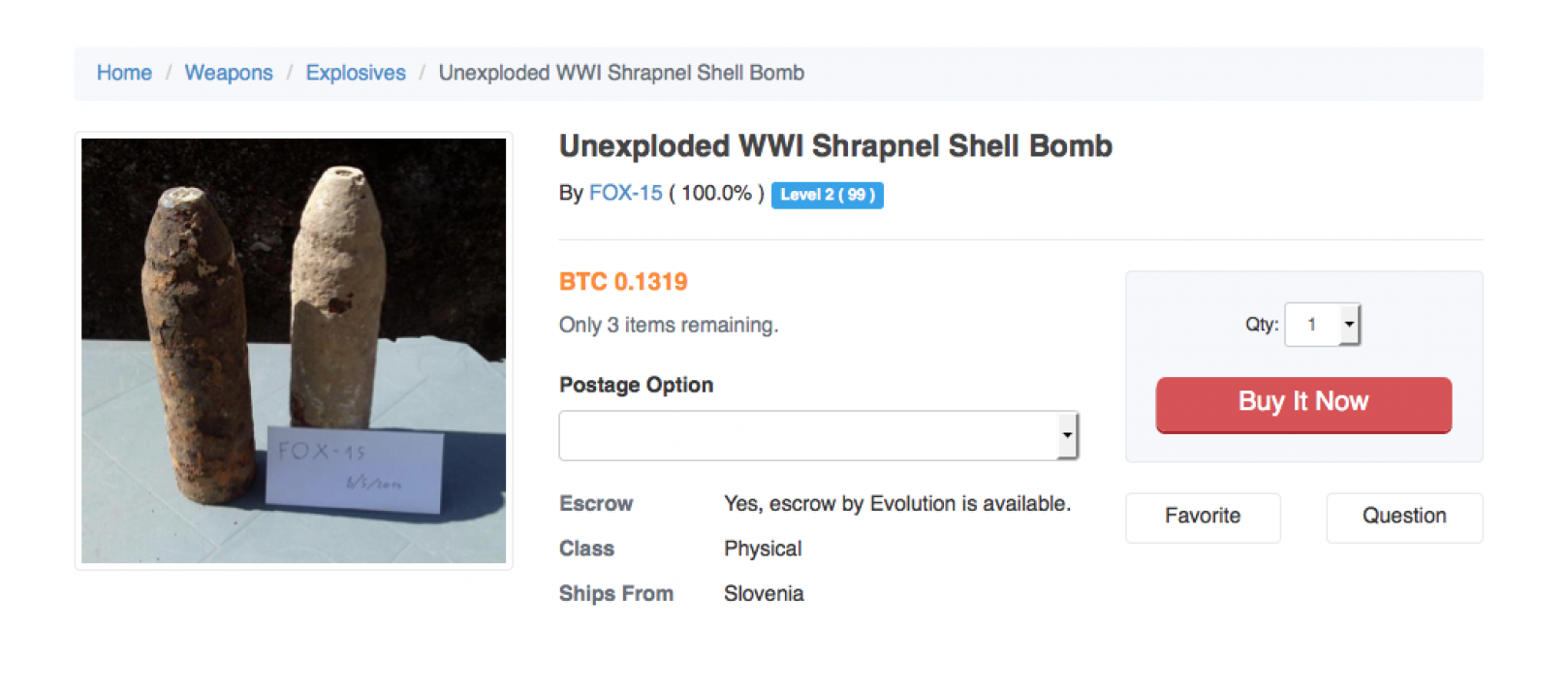
Now I don’t want to be accused of publicising this sort of nonsense. So while you all know this already, let me make things explicitly clear:
Handling unknown ordnance, in an unknown state is very dangerous and shipping it through the post is illegal and puts others at risk. If you want to do something dangerous, go and poke yourself in the eye with a sharp stick, or juggle a chainsaw in the dark. Ordering this could kill you or others and I hope would result in both the buyer and vendor serving long and uncomfortable jail sentences. Even if it doesn’t explode it is still stupid.